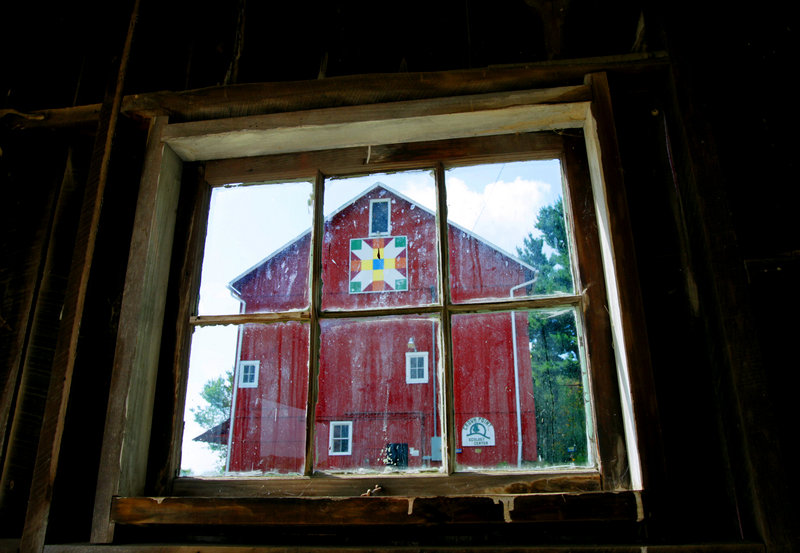Paintings of quilt squares are popping up on barns around the country.
But they’re more than just a folksy attempt to beautify the rural landscape. These are the engines of a movement to promote tourism and spark economic development across rural America.
The movement was started by an Ohioan, Donna Sue Groves, and is the subject of the new book “Barn Quilts and the American Quilt Trail Movement” by Suzi Parron.
It all started with one boring tobacco barn.
That barn belongs to Groves, who lives in southern Ohio’s rural Adams County. It’s on the nonworking farm she and her mother, Maxine Groves, bought in 1989, and its plainness bothered her.
She got the idea of painting a quilt-square design to beautify the unadorned exterior and honor her mother, a quilter. But years went by, and she never followed through.
“It got to be a joke among my friends,” she recalled. “They’d say, ‘Did you paint that quilt square yet?’ “
Still, the idea stayed in the back of her mind. And when she went to work for the Ohio Arts Council and saw how murals painted on buildings could be used to build community pride and spur tourism, she recognized that her simple idea could have similar implications.
Why paint just one quilt square on one barn, she thought. Why not paint quilt patterns on a bunch of barns and create an art trail?
Tourists could come to see them, and the dollars they’d bring would benefit hotels, bed and breakfasts, gas stations, restaurants and all sorts of businesses.
She was part of a group of volunteers that developed the concept, and in October 2001 Adams County put up the first square. “Mother didn’t get her quilt square till three years later,” Groves said with a laugh.
But a movement had begun.
In the years since, the quilt barn movement has spread to 43 states, where communities have created and installed quilt squares on barns or other sites and organized those sites into tourist trails.
The creation of a quilt barn trail is usually a well-planned undertaking that follows guidelines first established by the Adams County group and continually refined by groups that have followed. But “there are no hard-core rules that you have to follow,” Groves said.
Communities typically identify barns to highlight and then come together to paint the designs on 8-by-8-foot plywood squares and mount them on the barns, she explained. The trail is then publicized to bring in tourists.
The effort tends to build camaraderie, Groves said, especially around the creation of the quilt squares. “Children, elders, everybody can paint on them,” she said.
It also tends to spark entrepreneurial efforts by farms along the trail, such as corn mazes, shops and petting zoos.
Some communities have tweaked the idea to display quilt squares on significant buildings or even create freestanding displays of squares mounted on posts.
Of course, sometimes individuals put up their own quilt squares outside of organized trails, and that’s just fine with Groves.
“That will be a unique surprise along the trail,” she said. “I keep reminding people there are no barn police.”
Author Parron, who lives outside Atlanta, first encountered a quilt barn when she took a wrong road in Kentucky during a cross-country camping trip in 2008. She said she was impressed when she learned about the quilt squares’ purpose and especially liked that they honor the often-overlooked contributions of women to American agriculture.
“When you see a farm, you think of a man hard at work, not really a woman,” she said.
Parron thinks part of the appeal to the sponsoring communities is the chance to create art and display it for everyone to see. It’s almost the way a child feels when his or her artwork is hung on the refrigerator or the classroom bulletin board.
Some of the squares, like Groves’, are created to honor or remember a quilter. Parron related the story of one woman who created a barn quilt in the Dutch doll design that had special meaning for her mother. The mother was ill with ovarian cancer, so her daughter positioned the square where she could see it through her window.
Those kinds of efforts bring joy to Groves, who said the quilt barn movement has “totally sustained me” during her own battle with cancer in recent years.
Besides promoting tourism, Groves said the quilt barn trails honor what she calls “the backbone of America” and raises awareness of the contributions of rural residents.
“We who live in rural America are just blessed with wonderful attributes and opportunities,” she said.
She hopes some simple quilt square will help others recognize that.
Send questions/comments to the editors.



Success. Please wait for the page to reload. If the page does not reload within 5 seconds, please refresh the page.
Enter your email and password to access comments.
Hi, to comment on stories you must . This profile is in addition to your subscription and website login.
Already have a commenting profile? .
Invalid username/password.
Please check your email to confirm and complete your registration.
Only subscribers are eligible to post comments. Please subscribe or login first for digital access. Here’s why.
Use the form below to reset your password. When you've submitted your account email, we will send an email with a reset code.